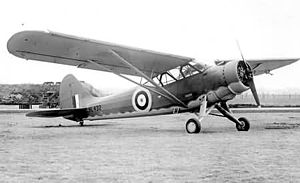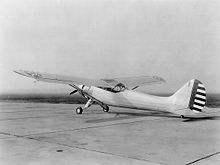- Stinson L-1 Vigilant
-
L-1 (O-49) Vigilant RAF Stinson Vigilant photographed at Air Fighting Development Unit, Duxford, UK, 1941-42 Role Light Observation, Liaison Manufacturer Stinson Aircraft Corporation Designer A.P. Fontaine First flight July 15, 1940 Introduction 1941 Primary users United States Army Air Corps
Royal Air ForceNumber built 324 The Stinson L-1 Vigilant (company designation Model 74) was a 1940s American light observation aircraft built by the Stinson Aircraft Company at Wayne, Michigan (by November 1940 a division of Vultee Aircraft Corporation)[1]. The aircraft was operated by the United States Army Air Corps as the O-49 until 1942.
Contents
Design and development
The Vigilant was designed in response to a 1938 United States Army Air Corps design competition for a two-seat light observation aircraft. When the German-manufactured Fieseler Storch was demonstrated at the Cleveland Air Races, the Air Corps revised its specifications in an attempt to match the performance of the Storch. Stinson (later a division of Vultee), won the $1.5 million contract over 11 competitors, including the Bellanca YO-50 and Ryan YO-51.[2]
The Model 74 was a single radial engined high-wing monoplane with trailing-edge high-lift devices for low speed and high lift performance. The prototype aircraft was built full-span leading-edge automatic slots manufactured by Handley Page, and slotted flaps. The Model V-74 was given the Army designation YO-49 for evaluation, with the first flight by test pilot Al Schramm on July 15, 1940.[2]
The aircraft was built of steel tubing and fabric, with the fuselage forward of the wing enclosed in sheet metal. Control surfaces and the empennage were fabric-covered stainless steel. The Lycoming power plant was hand-cranked inertia starting, and was fitted with a Hamilton Standard constant speed propeller. At least twelve ambulance conversions were fitted with Edo 49-4000 pontoons (4000-pound displacement)[3] for amphibious landings and takeoffs.[2]
The Vigilant was capable of stopping in less than its own length, and could maintain stable flight at 31 miles per hour. Anecdotally, the Vigilant was said to be capable of backwards flight in a strong headwind.[2]
Operational history
The Stinson Vigilant was used in diverse roles such as towing training gliders, artillery spotting, liaison, emergency rescue, transporting supplies, and special espionage flights[4]. Another contract was later awarded for the O-49A which had a slightly longer fuselage and other equipment changes. In April 1942 the aircraft were redesignated the L-1 and L-1A (liaison). Up to 17 L-1 and 96 L-1A aircraft were allocated to the British Royal Air Force under the Lend-Lease Act, with varying numbers given for aircraft actually delivered (see Variants, below). The RAF designated the aircraft the Vigilant Mk I and Vigilant Mk II respectively. General Harry Crerar, Commander of the First Canadian Army in Europe during World War Two, maintained a Vigilant for his personal use.
Aircraft were modified for a variety of roles including as an ambulance aircraft. No further production orders were placed as the aircraft was superseded by procurement of vast numbers of the L-5 Sentinel and L-4 Grasshopper "puddle-jumper" aircraft.
A Vigilant was modified in 1943-44 for experiment in boundary layer control[5]
Five examples of the Stinson O-49 Vigilant currently survive in museums in the United States.[6]
Variants
- Stinson Model 74
- company designation
- O-49 Vigilant
- US Army designation for first production batch, 142 built.[3]
- L-1 Vigilant
- 1942 redesignation of O-49.[3]
- O-49A Vigilant
- Fuselage lengthened 13 in (33 cm)[7] 182 built.
- O-49B Vigilant
- Conversion to ambulance variant, three or four[8] converted.
- L-1A Vigilant
- 1942 redesignation of O-49A.[3]
- L-1B Vigilant
- 1942 redesignation of O-49B.[3]
- L-1C Vigilant
- L-1A ambulance variant, 113 converted.[8]
- L-1D Vigilant
- L-1A training glider tug, 14 to 21[8] converted.
- L-1E Vigilant
- L-1 amphibious ambulance variant, seven converted.[3]
- L-1F Vigilant
- L-1A amphibious ambulance variant, five conversions.[3]
- Vigilant Mk I
- RAF designation of L-1, 14[8] to 17 allocated by Lend Lease
- Vigilant Mk II
- RAF designation of L-1A, 96 allocated, circa 13 to 54[8] delivered
- CQ-2 Vigilant
- US Navy conversion of L-1A to target control aircraft, one or more[8] converted
Operators
Specifications (L-1A)
Data from American Warplanes of World War II[9]
General characteristics
- Crew: 3
- Length: 34 ft 3 in (10.44 m)
- Wingspan: 50 ft 11 in (15.52 m)
- Height: 10 ft 2in (3.10 m)
- Wing area: 329 ft² (30.6 m²)
- Empty weight: 2670 lb (1211 kg)
- Max takeoff weight: 3400 lb (1542 kg)
- Powerplant: 1 × Lycoming R-680-9 radial piston engine, 295 hp (220 kW)
Performance
- Maximum speed: 106 knots (122 mph, 196 km/h)
- Range: 243 nm (280 mi, 451 km)
- Service ceiling: 12,800 ft (3900 m)
- Rate of climb: 408 ft/min (124.36 m/min)
- Wing loading: 10.3 lb/ft² (50.4 kg/m²)
- Power/mass: 0.0867 hp/lb (0.143 kW/kg)
See also
- Aircraft of comparable role, configuration and era
- Related lists
- List of aircraft of the Royal Air Force
- List of military aircraft of the United States
References
Notes
- ^ Eden and Moeng 2002, p. 1100.
- ^ a b c d Merriam 2002, p. 26.
- ^ a b c d e f g Merriam 2002, p. 27.
- ^ Photo Gallery
- ^ "Money-box Slottery" Flight 4th August 1949 p 124
- ^ Ogden, 2007, p. 604
- ^ "Vultee L-1A Vigilant". National Museum of the United States Air Force. http://www.nationalmuseum.af.mil/factsheets/factsheet.asp?id=473. Retrieved 17 April 2009.
- ^ a b c d e f "Stinson O-49". Aerofiles. http://www.aerofiles.com/_stin.html. Retrieved 17 April 2009.
- ^ Donald 1995, p. 236.
Bibliography
- Donald, David (ed.). American Warplanes of World War II. London: Aerospace Publishing, 1995. ISBN 1-874023-72-7.
- Eden, Paul and Soph Moeng (eds.). The Complete Encyclopedia of World Aircraft. Amber Books Ltd., 2002. ISBN 0-7607-3432-1
- Merriam, Ray (ed.). World War II Journal #15: U.S. Military Aircraft of World War II. Bennington, Vermont, USA: Merriam Press, 2002. ISBN 1-57638-167-6.
- Ogden, Bob. Aviation Museums and Collections of North America. (2007) Air-Britain (Historians ) Ltd. ISBN 0-85130-385-4.
- The Illustrated Encyclopedia of Aircraft (Part Work 1982-1985). London: Orbis Publishing.
External links
- Vultee L-1A Vigilant, National Museum of the United States Air Force
- Stinson O-49 on aerofiles
- Popular Science, September 1941, Grasshoppers see page 66-67 for O-49 details and photos
Aircraft produced by Stinson Aircraft Corporation Civil designations Military designation Names Aircraft produced by Vultee Manufacturer designations V-1 · V-11 · V-12 · V-20 · V-32 · V-33 · V-35 · V-37 · V-38 · V-39 · V-40 · V-41 · V-42 · V-43 · V-44 · V-45 · V-46 · V-47 · V-48 · V-49 · V-50 · V-51 · V-52 · V-54 · V-55 · V-56 · V-57 · V-58 · V-61 · V-69 · V-70 · V-72 · V-74 · V-75 · V-76 · V-77 · V-78 · V-80 · V-83 · V-84 · V-85 · V-86 · V-88 · V-90
Model numbering continued by Convair
By role Designation sequences for this aircraft: USAAF/USAF liaison aircraft USAAC/USAAF observation aircraft Observation O-1 • O-2 • XO-3 • XO-4 • O-5 • O-6 • O-7 • O-8 • O-9 • XO-10 • O-11 • O-12 • O-14 • XO-14 • XO-15 • XO-16 • O-17 • XO-18 • O-19 • YO-20 • XO-21 • O-22 • YO-23 • O-24 • O-25 • Y1O-26 • Y1O-27 • O-28 • O-29 • O-30 • O-31 • O-32 • Y1O-33 • O-34 • O-35 • XO-36 • O-37 • O-38 • O-39 • O-40 • Y1O-41 • O-42 • O-43 • XO-44 • O-45 • O-46 • O-47 • XO-48 • O-49 • YO-50 • YO-51 • O-52 • O-53 • YO-54 • YO-55 • O-56 • O-57 • O-58 • O-59 • O-60 • XO-61 • O-62 • XO-63
Observation Amphibian USAAF drone aircraft Controllable bombs Target control aircraft Aerial target (subscale) Aerial target (full-scale) Lists relating to aviation General Aircraft (manufacturers) · Aircraft engines (manufacturers) · Airlines (defunct) · Airports · Civil authorities · Museums · Registration prefixes · Rotorcraft (manufacturers) · TimelineMilitary Accidents/incidents Records Categories:- United States military reconnaissance aircraft 1940–1949
- Stinson aircraft
Wikimedia Foundation. 2010.



